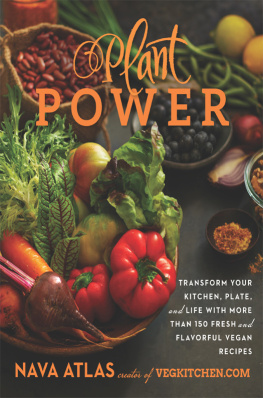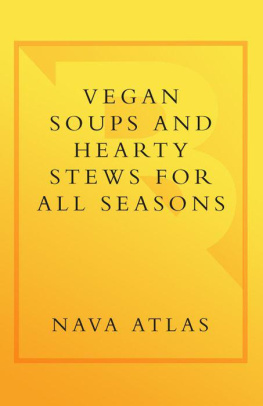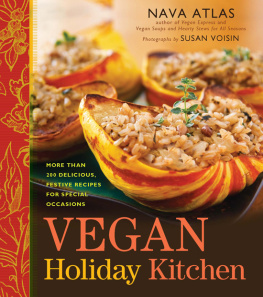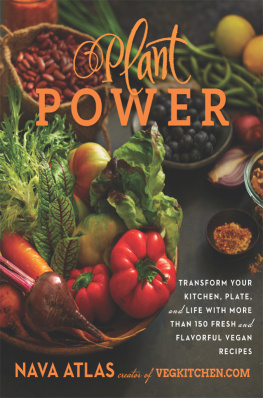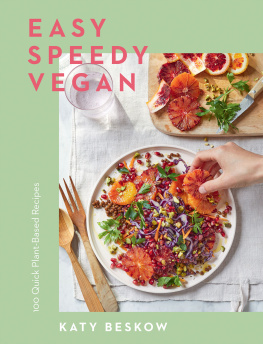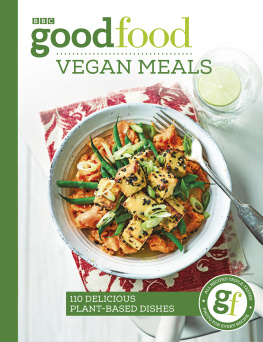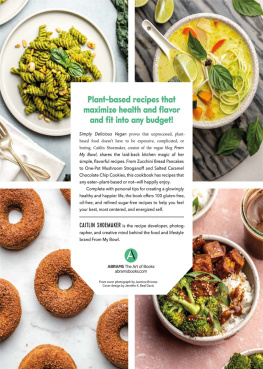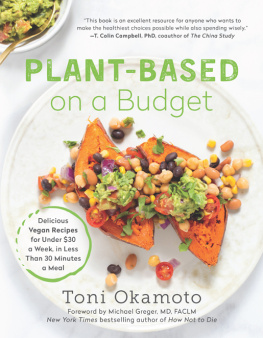
CONTENTS

Interest in plant-based diets and lifestyles has grown exponentially in the past decade. And with it there has been a proliferation of books, websites, publications, and other media promoting plant-based eating. Want to know more about the health benefits of eating plant foods? The information is easy to find. Ethical considerations? Check. Recipes, plain and fancy? Theyre out there in droves. Vegan cupcakes and other treats free of animal products? Theyre showing up everywhere.
Whether you call it vegan, plant-based, plant-strong, or plant-powered, its in the air, but all the information floating around can be overwhelmingand confusing. What this book aims to give you is one neat volume on how to put the edible elements of the plant-powered lifestyle into practiceeasily, practically, and joyfully, every day. In Plant Power, youll find not just a collection of accessible, adaptable recipes but also a slew of helpful tips and ideas. Whether youre looking to transition to a fully vegan lifestyle or just want to explore a more plant-based diet, youll find plenty of inspiration and encouragement in these pages.
Going beyond why you should adopt this way of life, this guide will focus on how to do it, from setting up a whole-foods, plant-based pantry and refrigerator and planning practical menus to choosing the best seasonal fresh foods and streamlining daily meal preparation. And what are whole foods? Theyre simply foods that are as close to the state theyre in when harvestedunprocessed and natural, like brown rice, beans, carrots, and apples, for instance.
This book is also a celebration. A switch to a plant-based diet doesnt mean sacrifice or missing out; we get to revel in and enjoy the most flavorful, colorful, life-enhancing foods available. Depending on how consistently you practice it, you may find that adopting this way of life confers numerous benefits, including the expected onesincreased energy, fewer digestive issues, less frequent and shorter colds, and maybe even weight loss. And though many whove gone plant-based have reported such perks and more, this book isnt a health and weight-loss guide. Rather, it shows us how to have more fun in the kitchen, become more intuitive and creative with whole foods, and gain an appreciation for how downright delicious foods in their most elemental, unprocessed form can be! What Id like you to take away from these pages is a message of ease, abundance, and pleasure. Cooking with the most healthful (not the most exotic or expensive) ingredients nature has to offer is a joy, not a chore!
Many people transitioning to a plant-based diet go vegetarian first. Its a logical step, and many have gone the route of giving up red meat, then poultry, and finally fish. And similarly, those deciding to go from vegetarian to vegan give up dairy first, then eggsor vice versa. But I know plenty of people who, having experienced a major health event (such as a heart attack or cancer), go plant-based all at once. In other cases, its not illness but ethics that inspires a cold-turkey (so to speak) conversion. Suddenly what we didnt knowor didnt want to knowbecomes too compelling to deny or ignore.
This books aim is not to convince you to go vegan. Ultimately thats a decision you need to make with your heart as much as with your head. With recipes, menus, and strategies (along with Hannah Kaminskys mouthwatering photographs), this book aims to take you on an enjoyable visual journey, demonstrating how gratifying and delicious a plant-powered life can be. If a daily habit of meat, dairy, and/or junk food falls away or at least diminishes, so much the better for your health, the planet, and the cause of compassion. Any steps taken are to be applauded; going vegan need not be an all-or-nothing proposition.
Whether your decision to adopt a more plant-based way of life is driven by health or ethical concerns, you still need to eat every day. This guide will take you through the practical steps in the kitchen and tempt you with many delectable and doable meals.
To that end, I wont plunge you into a world of unfamiliar and expensive foods. Thats not what a whole-foods, plant-based diet is about. On the contrary: unless meat is at the center of your plate at each meal each day, youll find lots of common ingredients and preparations, including pastas, pizzas, sandwiches and wraps, soups, stews, stir-fries, and saladsthe kinds of meals youre already familiar with. Im going to show you how easy it is to make more healthful, plant-powered versions of the kinds of meals you already like.
That said, you wont find highly processed meat substitutes in this book, either. Thats not what plant-based eating is about. Meat substitutes are helpful for many who are making the transition. But in general, theyre salty, expensive, and often contain questionable ingredients such as isolated soy protein. Enjoy them as a treat occasionally if you must, but you dont need a cookbook to tell you how to use them.
What about ingredients for all these plant-based meals? I do my grocery shopping in a town where there are two major supermarkets and a couple of small but well-stocked natural foods stores. There are plenty of CSA (community-supported agriculture) farms and farm markets, though these are seasonal. We have no Whole Foods, no Trader Joes, and no ethnic groceries. While these might be fun to have close at hand, theyre not at all necessary for enjoyment of plant-based living.
Many supermarkets now have natural foods aisles that bear a striking resemblance to natural foods superstoresonly without the fancy prices. In addition, ethnic foods aisles in regular supermarkets now offer items that were once arcane, like chipotle peppers in adobo sauce and hoisin marinade. My favorite supermarket meets almost all of my basic organic produce needs, perfect for those months when no farm markets are open. From what Ive seen during my travels, it seems this trend is spreading. So if I can fulfill my familys plant-based needs where I live, chances are you can, too.
The food writer Michael Pollan summed up the goal for a sound and healthy way of life when he popularized the succinct phrase Eat food. Not too much. Mostly plants. It sounds so simple, but for many its an elusive goal. This books aim is to help you get there in a way thats easier and more delectable than you ever thought possible.

By training, Im a visual artist, illustrator, and graphic designer. Ive never been a chef or caterer. Ive never even worked in a restaurant, unless you count the summer I was sixteen, when I was a very confused and slow waitress. It was at just about that age that I went vegetarian, and in that era, the word vegetarian was not yet casually bandied about. I was a pioneer within my family (in which I was the youngest by far), though it was more an act of rebellion than conviction. I never liked meat and couldnt bear to look at it on my plate; it often made me want to cry, and sometimes I shed actual tears.
My announcement that I was giving up all meat was met with chagrin by my parents; my mom told me I would have to cook for myself, as she wasnt about to prepare two different meals. This response is quite typical, as Ive learned from my many years of corresponding with kids and teens who wonder how to get their parents on board. What I did was to start preparing my own mealsconcoctions centered on brown rice, lentils, barley, wheat berries, and all the brown foods prevalent in that hippie-vegetarian era. As meals go, they were nothing special, but to me they were heavenly. They must not have been half bad, since my family wanted to try my meals, and I was happy to share. Soon even my skeptical mom was making meals that I could eat, an improvement over the bland, meaty Eastern European Jewish fare Id grown up with.

